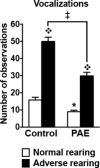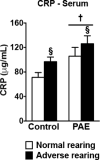Effects of early-life adversity on immune function are mediated by prenatal environment: Role of prenatal alcohol exposure
- PMID: 28698116
- PMCID: PMC5650917
- DOI: 10.1016/j.bbi.2017.07.001
Effects of early-life adversity on immune function are mediated by prenatal environment: Role of prenatal alcohol exposure
Abstract
The contribution of the early postnatal environment to the pervasive effects of prenatal alcohol exposure (PAE) is poorly understood. Moreover, PAE often carries increased risk of exposure to adversity/stress during early life. Dysregulation of immune function may play a role in how pre- and/or postnatal adversity/stress alters brain development. Here, we combine two animal models to examine whether PAE differentially increases vulnerability to immune dysregulation in response to early-life adversity. PAE and control litters were exposed to either limited bedding (postnatal day [PN] 8-12) to model early-life adversity or normal bedding, and maternal behavior and pup vocalizations were recorded. Peripheral (serum) and central (amygdala) immune (cytokines and C-reactive protein - CRP) responses of PAE animals to early-life adversity were evaluated at PN12. Insufficient bedding increased negative maternal behavior in both groups. Early-life adversity increased vocalization in all animals; however, PAE pups vocalized less than controls. Early-life adversity reduced serum TNF-α, KC/GRO, and IL-10 levels in control but not PAE animals. PAE increased serum CRP, and levels were even higher in pups exposed to adversity. Finally, PAE reduced KC/GRO and increased IL-10 levels in the amygdala. Our results indicate that PAE alters immune system development and both behavioral and immune responses to early-life adversity, which could have subsequent consequences for brain development and later life health.
Keywords: Amygdala; C-reactive protein; Cytokines; Early-life adversity; Maternal behavior; Prenatal alcohol exposure; Rat.
Copyright © 2017 Elsevier Inc. All rights reserved.
Figures





Similar articles
-
Exposure to Chronic Mild Stress Differentially Alters Corticotropin-Releasing Hormone and Arginine Vasopressin mRNA Expression in the Stress-Responsive Neurocircuitry of Male and Female Rats Prenatally Exposed to Alcohol.Alcohol Clin Exp Res. 2015 Dec;39(12):2414-21. doi: 10.1111/acer.12916. Epub 2015 Nov 18. Alcohol Clin Exp Res. 2015. PMID: 26578428 Free PMC article.
-
Evidence for an immune signature of prenatal alcohol exposure in female rats.Brain Behav Immun. 2016 Nov;58:130-141. doi: 10.1016/j.bbi.2016.05.022. Epub 2016 Jun 2. Brain Behav Immun. 2016. PMID: 27263429 Free PMC article.
-
Dysregulation of immune system markers, gut microbiota and short-chain fatty acid production following prenatal alcohol exposure: A developmental perspective.Neurochem Int. 2025 May;185:105952. doi: 10.1016/j.neuint.2025.105952. Epub 2025 Feb 21. Neurochem Int. 2025. PMID: 39988283
-
The maternal-placental-fetal interface: Adaptations of the HPA axis and immune mediators following maternal stress and prenatal alcohol exposure.Exp Neurol. 2022 Sep;355:114121. doi: 10.1016/j.expneurol.2022.114121. Epub 2022 May 20. Exp Neurol. 2022. PMID: 35605668 Free PMC article. Review.
-
Early life adversity exposure and circulating markers of inflammation in children and adolescents: A systematic review and meta-analysis.Brain Behav Immun. 2020 May;86:30-42. doi: 10.1016/j.bbi.2019.04.028. Epub 2019 Apr 15. Brain Behav Immun. 2020. PMID: 30999015 Free PMC article.
Cited by
-
Choline Supplementation Modifies the Effects of Developmental Alcohol Exposure on Immune Responses in Adult Rats.Nutrients. 2022 Jul 13;14(14):2868. doi: 10.3390/nu14142868. Nutrients. 2022. PMID: 35889826 Free PMC article.
-
Immune network dysregulation associated with child neurodevelopmental delay: modulatory role of prenatal alcohol exposure.J Neuroinflammation. 2020 Jan 28;17(1):39. doi: 10.1186/s12974-020-1717-8. J Neuroinflammation. 2020. PMID: 31992316 Free PMC article.
-
Prenatal alcohol-induced sex differences in immune, metabolic and neurobehavioral outcomes in adult rats.Brain Behav Immun. 2021 Nov;98:86-100. doi: 10.1016/j.bbi.2021.08.207. Epub 2021 Aug 11. Brain Behav Immun. 2021. PMID: 34390803 Free PMC article.
-
Toxic and Teratogenic Effects of Prenatal Alcohol Exposure on Fetal Development, Adolescence, and Adulthood.Int J Mol Sci. 2021 Aug 16;22(16):8785. doi: 10.3390/ijms22168785. Int J Mol Sci. 2021. PMID: 34445488 Free PMC article. Review.
-
Association of Prenatal Alcohol Exposure and Prenatal Maternal Depression with Offspring Low-Grade Inflammation in Early Adolescence.Int J Environ Res Public Health. 2021 Jul 27;18(15):7920. doi: 10.3390/ijerph18157920. Int J Environ Res Public Health. 2021. PMID: 34360212 Free PMC article.
References
-
- Alberry B, Singh SM. Developmental and behavioral consequences of early life maternal separation stress in a mouse model of fetal alcohol spectrum disorder. Behavioural Brain Research. 2016;308:94–103. - PubMed
-
- Andersen SL. Trajectories of brain development: Point of vulnerability or window of opportunity? Neuroscience & Biobehavioral Reviews. 2003;27:3–18. - PubMed
-
- Babri S, Doosti MH, Salari AA. Tumor necrosis factor-alpha during brain development affects anxiety- and depression-like behaviors in adult male and female mice. Behavioural Brain Research. 2014;261:305–314. - PubMed
-
- Bajetto A, Bonavia R, Barbero S, Florio T, Schettini G. Chemokines and their receptors in the central nervous system. Frontiers in Neuroendocrinology. 2001;22:147–184. - PubMed
-
- Barron S, Segar TM, Yahr JS, Baseheart BJ, Willford JA. The effects of neonatal ethanol and/or cocaine exposure on isolation-induced ultrasonic vocalizations. Pharmacology, Biochemistry and Behavior. 2000;67:1–9. - PubMed
MeSH terms
Substances
Grants and funding
LinkOut - more resources
Full Text Sources
Other Literature Sources
Research Materials
Miscellaneous

